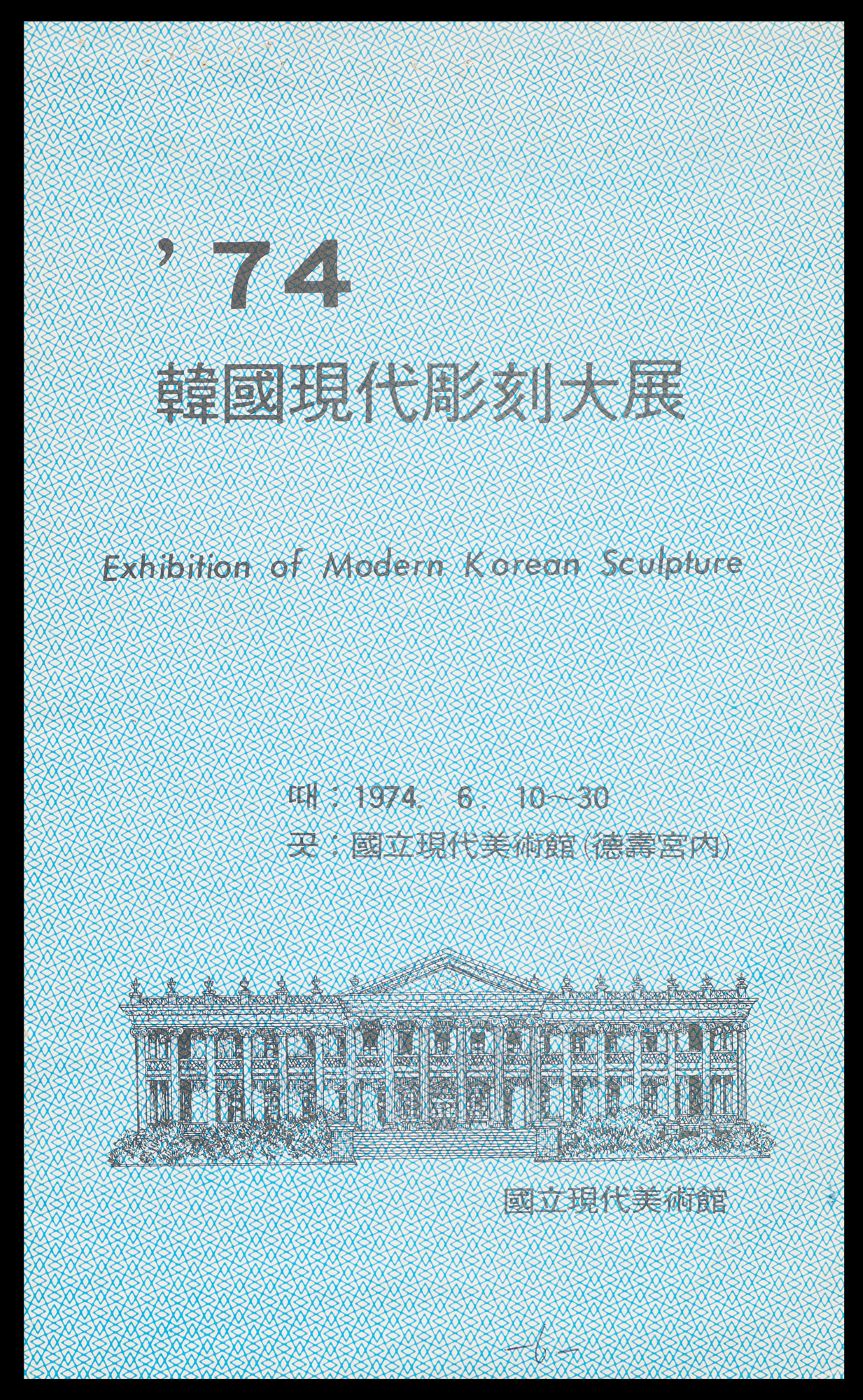
'74 Exhibition of Modern Korean Sculpture, Brochure, 1974, MMCA Art Research Center Collection
Modern Korean Art Exhibition
* Source: MMCA
Related
-
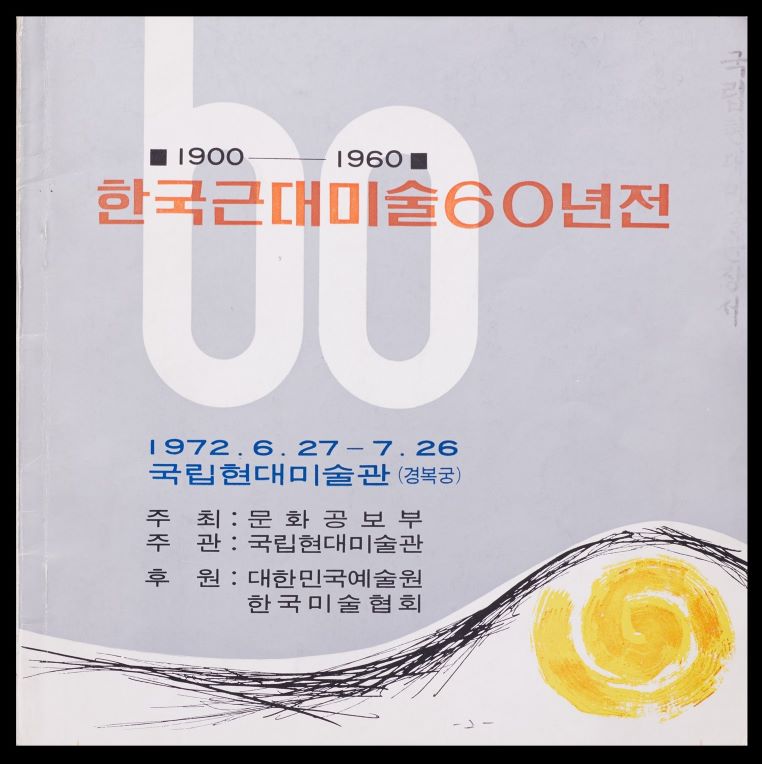
60 Years of Modern Korean Art
An exhibition held from June 27 to July 26 1972 at the National Museum of Modern Art, Korea (now MMCA). The exhibition was the first to focus on Korean modern art, and is considered the foundation upon which the museum established its own collection. Artists such as Kim Eunho, Kim Kyongseung, and To Sangbong, and art historians such as Lee Kyungsung and Choi Sunu planned the exhibition together. The museum did not own many works of modern art at the time, so the artworks were collected from the artists, family members of artists, and collectors through public media advertisements. A total of 564 works were exhibited, including ink wash paintings, oil paintings, calligraphy, and sculpture. The museum purchased the works that were exhibited on a steady basis thereafter to establish its own collection. Many artworks that are today considered as highly significant, including Lee Chongwoo’s Still Life with a Doll (1927), Lee Jungseop’s Fighting Fowls (1955), Ko Huidong’s Self-portrait (1915), Gu Bonung’s Portrait of a Friend (1935), and Kim Whanki’s Rondo (1938), all became part of the museum’s collection through this exhibition.
-
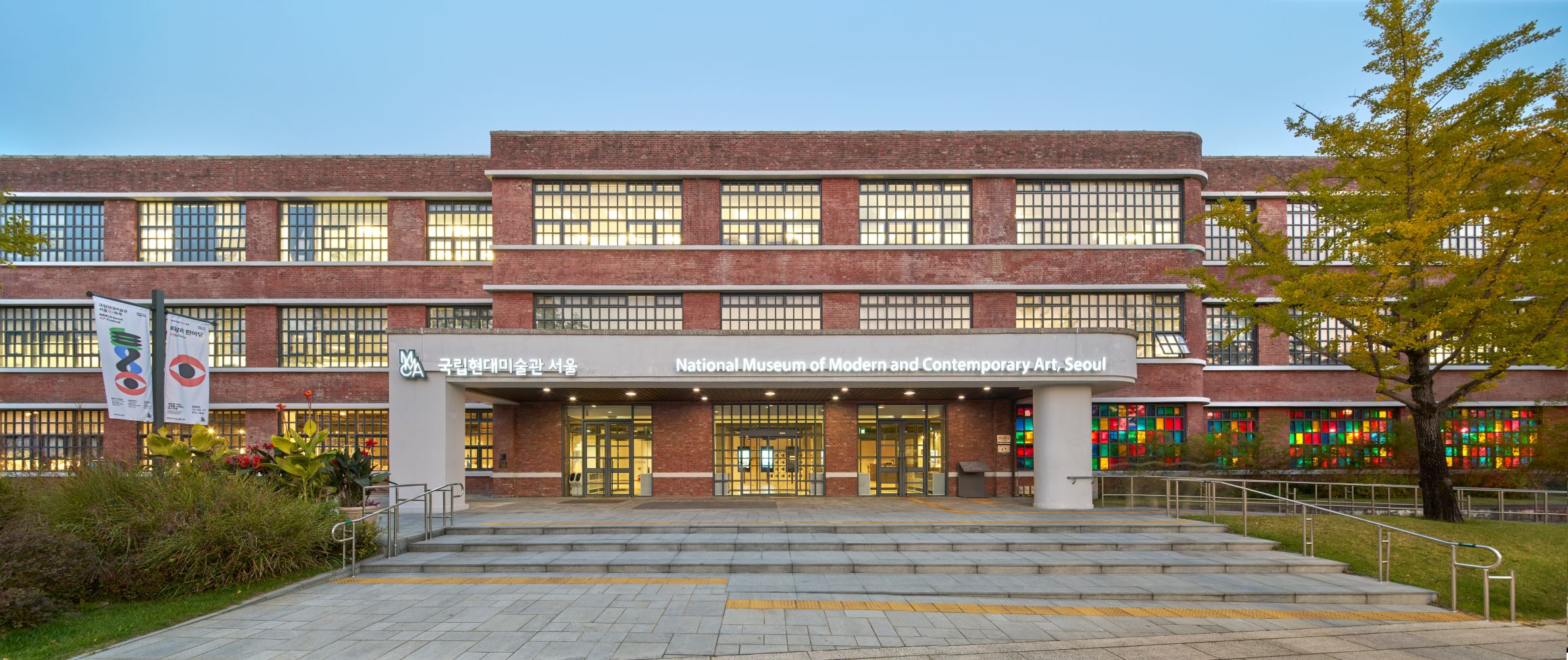
National Museum of Modern and Contemporary Art, Korea (MMCA)
A national museum established in 1969 that researches, collects, and exhibits modern and contemporary art. As of 2018, there are branches in Gwacheon, Deoksugung, Seoul, and Cheongju. When first established, the National Museum of Modern Art (now MMCA) was located within Gyeongbokgung palace. In 1973, the museum moved to the East Wing of the Deoksugung Seokjojeon building. Then, in 1986, the museum moved to its current location in Gwacheon, to occupy a new building equipped with an outdoor sculpture exhibition space, and has since opened a new chapter in Korean art. The perceived need for a space to focus specifically on Korean contemporary art led to the establishment of further site, the National Museum of Contemporary Art, Deoksugung in 1998. In November 2013, a further demand for contemporary art exhibitions led to the establishment of another Seoul branch being created in the Defense Security Command building in Sogyeok-dong, Jongno-gu, which has since its inception engaged in multifaceted exhibitions of both domestic and overseas contemporary art. Also, as a further component of the MMCA complex, a disused tobacco factory in Cheongju was remodeled to provide a home to the National Art Storage Center.
-

100 years of Korean art
100 Years of Korean Art was a special exhibition held at the National Museum of Contemporary Art, Korea (now MMCA) to commemorate the sixtieth anniversary of Korea's independence. It offered an overview of Korean art from 1905 to 2005 in two parts. Art historian Kim Hyunsook orchestrated the entire project. Part 1, which covered art from 1905 to 1959, was held from August 13 to October 23 in 2005, and Part 2, which oversaw art from 1960 to 2005, was held from June 2 to September 10, 2006. Part I of the exhibition was segmented into six periods as follows: “Prehistory—Towards Modernity: 1876-1905,” “Between Enlightenment and the Anti-Japanese Movement: 1905–1919,” which oversaw visual art during the anti-Japanese and patriotic movements as well as contemporaneous Korean art as seen by foreigners; “The Bright and Dark Sides of the New Culture: 1919–1937” focusing on the art that evolved by accepting new cultural trends and was directed toward autonomous modernity; “From Modernism to Imperial Citizens: 1937–1945” covering avant-garde art to pro-Japanese art; “Liberation and Division: 1945–1953” focusing on art created after liberation from Japan under the US military government, and during the Korean War; and “The Shadow of the Cold War: 1953–1960.” Part 2 of the exhibition was divided into four themes and periods: “1957–1966: Invitational Exhibition of Contemporary Artists” showing the proliferation of the new post-war art form, Art Informel, under the subtitle “Tradition, Humanity, Art, Reality”; “1967–1979: Young Artists' Union Exhibition," focusing on experimental art; “1980–1987: 5.18 Gwangju Democratization Movement,” displaying socially engaged art and folk art; and “1988–Present: Seoul Olympics,” overseeing the post-modernist and globalization trends in the late 1980s. As 2006 marked the 20th anniversary of the relocation of the National Museum of Contemporary Art, Korea from Deoksugung Palace to Gwacheon, the academic events that were part of the first and second exhibitions of 100 Years of Korean Art were posted online and named the "20th Anniversary of the Relocation to Gwacheon Online Exhibition." 100 Years of Korean Art was a new kind of exhibition that attempted to include not only fine art, but also visual culture in general, including painting, sculpture, calligraphy, crafts, design, advertising, photography, film, and architecture, as well as archives, in Gallery 1, 2, and 7 and the central hall of the National Museum of Contemporary Art, Korea Gwacheon. It was also an attempt to show 100 years of Korean art as an integrated product formed in political, social, and cultural contexts. The exhibition catalogue for Part I was published in 2006 as a 707-page book by Hansgilsa Publishing Co. with the participation of Kim Yoon-Soo and fifty-seven other contributors. The exhibition catalogue for Part 2 was published in 2006 as a 45-page book by the National Museum of Contemporary Art, Korea.
Find More
-

Lee Kyungsung
Lee Kyungsung (1919-2009, pen name Seoknam) was born in Incheon as the first son of Lee Hak-soon and Jin Bo-bae. He graduated from Changyeong Elementary School (1926-31) and Gyeongseong Commercial School (1934-36). In 1937, he moved to Japan and graduated from the Department of Law at Waseda University in 1941. After his return to Korea, he worked as a clerk at the Gyeongseong Court. Later, he returned to Japan to study art history at Weseda University. After independence, he was appointed as the first director of the Incheon City Museum, a director of Hongik University Museum, Walker Hill Art Center (1981-83), and the MMCA (1981-83, 1986-92). He strived to improve the structure of Korean art museums and also trained professional curators. During his appointment as a professor at Ewha Womans University (1957-60) and Hongik University (1961-81), he also served as a chair of the Korean Art Critics Association and published several important books that contributed to the foundation of a modern Korean art history. He established the Seoknam Art Culture Foundation in 1989 and the Seoknam awards for art and art theory. After his retirement, he focused on his art and held numerous solo exhibitions.
-
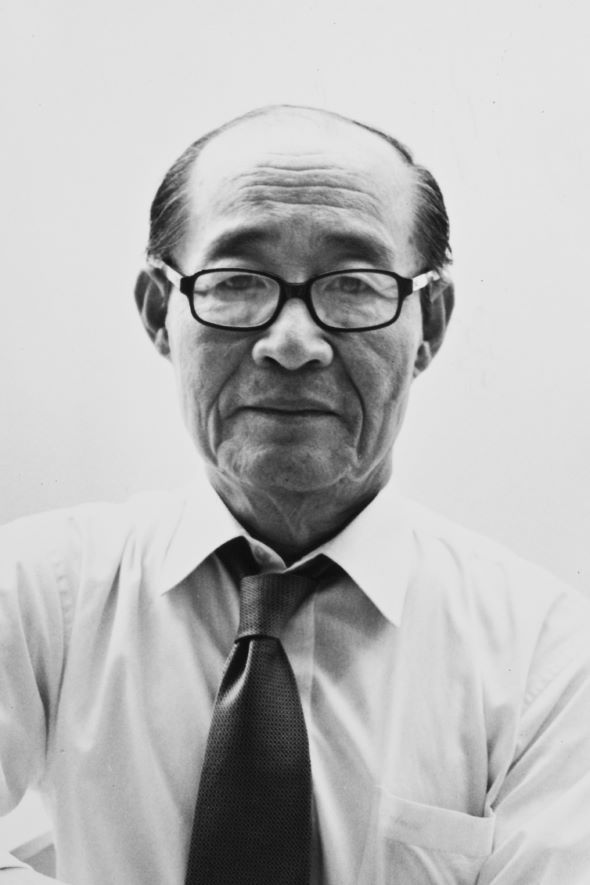
Yu Jun-sang
Yu Jun-sang (1932-2018) was a founding member of the Korean Art Critics Association [Hanguk misul pyeongnonga hyeophoe] along with Lee Yil and Oh Kwang-su. He has worked in various fields as a curator, educator, and art museum director. After graduating from the College of Commerce at Seoul National University in 1954, Yu moved to France in 1956 and pursued a Ph.D. in business administration at the University of Paris (Université de Paris) before dropping out. He studied painting at the Académie de la Grande Chaumière and audited the history of Western modern and contemporary art at the Liberal Arts Department of the University of Paris. After returning to Korea, he taught art theory courses at Hongik University, Seorabeol University of Arts, and Ewha Womans University. As an art critic, he served as president of the Korean Art Critics Association from 1972 to 1982. Yu participated in the selection of artists representing Korea for the exhibition of Contemporary Korean Painting held at The National Museum of Modern Art, Tokyo in 1968, and Korean Contemporary Art: 1957–1972 held at the Myeong-dong Gallery in 1973. He was head of the curatorial department at the National Museum of Contemporary Art, Korea (now MMCA) from 1986 to 1992 and as director of the Seoul Museum of Art from 1999 to 2002. He also laid the foundation for Korean art criticism by assuming charge of editing the magazines Hyeondae Misul of Myeong-dong Gallery in 1974 and Sun misul of Sun Gallery from 1979 through 1983. His publications can be divided into those that attempt a conceptual or aesthetic approach and those that discuss the works of other artists. The former include Korean Contemporary Art 12: Stylization of Korean Sentiments (Hanguk Ilbo newspaper company, 1977, 82–108) and “Prospects and Possibilities for Computer Art: A Focus on Patterns of Perception and Artistry” in Beyond Modernism (Yesul jisik, 1989, 298–315). Among the artists that Yu addressed with interest were Rhee Seundja, Kwon Jinkyu, Quac Insik, Moon Shin, Nam Kwan, Kwon Okyon, Kim Whanki, Chang Dookun, Lee Seduk, Han Mook, Moon Hakjin, Park Hangsup, Choi Youngrim, and Kim Sechoong. Yu was particularly interested in the generation of artists who had received art training before Korea’s liberation from Japan as well as those who had lived in France.
-
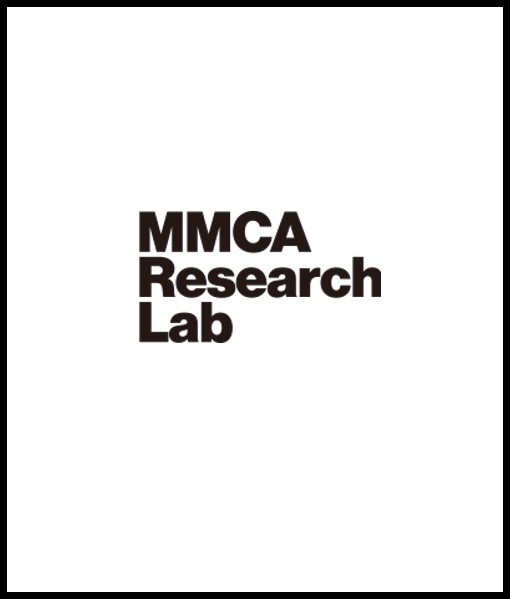
Lee Gu-yeol
Lee Gu-yeol(1932-2020) was the first art journalist, an art critic, and a researcher of modern art in Korea. Born in Yeonbaek, Hwanghae-do Province, Lee went to South Korea during the Korean War. He enlisted in the army as a cadet, completed infantry and artillery schools, and served as an officer during the war. After being discharged as a captain in 1958, he joined World Telecommunications and worked in the publications department. In 1959, he enrolled as a junior in the College of Fine Arts at Hongik University, but he could not finish his studies. He worked as an art reporter in the culture desk of Segye Ilbo newspaper (renamed the Minguk Ilbo in 1960) and then as a reporter and deputy head of the culture desk of Kyunghyang Shinmun newspaper in and after 1962. In 1970, he transferred to Seoul Sinmun newspaper and served as the head of its culture desk. He became the head of the culture desk of Daehan Ilbo newspaper in 1972 but ended his journalistic career when the company ceased to publish in 1975. In 1964, Lee was in charge of editing the quarterly magazine Misul (Art) (published by Munhwa Gyoyuk Chulpansa). He also organized the publication of fifteen volumes of the Complete Collection of Korean Art (sponsored by Donghwa Chulpan Gongsa) and worked as chief editor from 1973 through 1975. He served as president of the Korean Art Critics Association (1984–1985), a member of the Cultural Heritage Committee of the Ministry of Culture and Tourism (1992–1999), and as director of exhibition projects at the Seoul Arts Center (1993–1996). He also opened the Korean Modern Art Research Institute and published its irregular periodical Modern Art of Korea from the first to fifth issues (1975–1977). His books include The Realm of Painting: The Life and Art of Idang (1968), A Study on Modern Korean Art (1972), The Development of Modern Korean Art (1982), Research on Modern Korean Art History (1992), History of Modern Korean Painting (1993), 50 Years of North Korean Art (2001), The Story behind Modern Korean Art (2005), Rha Hyeseok: The Woman Who Drew Her Fiery Life (2011), Korean Cultural Heritage: A History of Suffering (2013), and My Days as an Art Reporter (2014). In 2018, he published two volumes of his self-edited literary collection Miscellany by Cheongyeo to celebrate his turning eighty-eight. Lee Gyu-yeol played a crucial role in the establishment of the Archives of Korean Art Journal, the first art archives in Korea, in December 1998 by donating his materials related to modern and contemporary art to the Samsung Museum of Art. In 2015, he donated more than 4,000 items to Gacheon Museum of the Gil Cultural Foundation. He passed away in 2020 at the age of eighty-nine.






